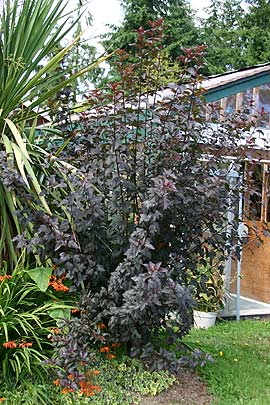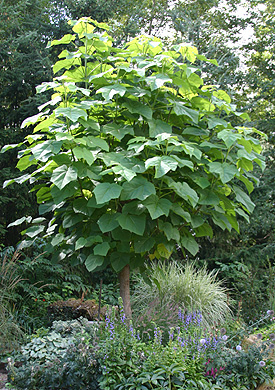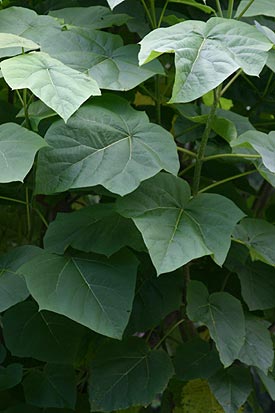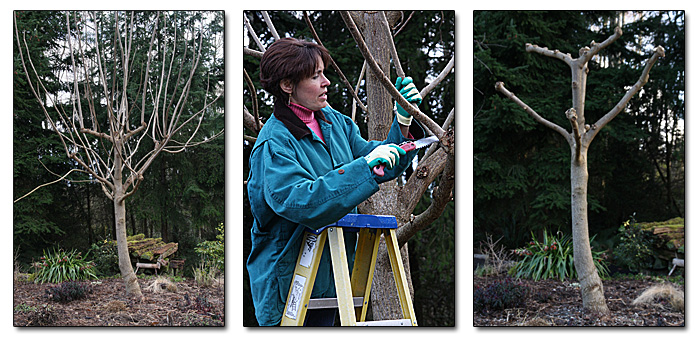Whack 'em Back
Keep the faith; while it's true that most trees and shrubs take great offense to chainsaw massacre, a few hardy souls accept amputation without complication.
by Wendy Tweten

All shrubby ninebarks, including Physocarpus 'Diablo', benefit from an annual semi-coppicing in which up to half of the old stems are removed each year.

The empress tree is more refined when trained as a pollard. ©2007

Keep the faith; while it's true that most trees and shrubs take great offense to chainsaw massacre, a few hardy souls accept amputation without complication. The first step is to learn two simple horticultural terms: coppicing and pollarding. This is important because when your spouse, neighbors and friends ask what happened to your Cornus stolonifera, you can answer confidently "I've coppiced it, of course," and, instantly, the cornus's crew cut is proof of your gardening expertise.
Coppicing
Coppicing is the act of cutting certain woody plants nearly to the ground. It originated thousands of years ago in Europe as a form of woodland management. The resulting suckers were traditionally used for fuel, weaving, woodworking, animal fodder and leather tanning. Most of today's home gardeners--unless interested in making wattle fences or shovel handles--use coppicing aesthetically to refresh and restrain shrubby plants.
The redtwig dogwoods, Cornus sanguinea, C. stolonifera and C. alba, as well as the color-stemmed willows, such as Salix alba, are excellent examples of plants that look best with annual coppicing. The new growth of these plants blazes through winter in shades of blood red, flame orange and brilliant yellow, depending on variety. With age, however, the branches darken and the flashy hues of youth are lost. To keep the color coming, shorten all stems to within three inches of the ground or to the pre-established bolls that form after years of coppicing (or pollarding). This should be done in late winter or early spring. For less vigorous growers, such as Cornus sanguinea 'Midwinter Fire', remove only one half to one third of the oldest stems each year. To compensate for the loss of flowers on coppiced plants, use them as a support for a clematis that can be pruned at the same time.
Shrubby plants such as ninebark (Physocarpus opulifolius), weigela (Weigela florida) and forsythia all benefit from an annual semi-coppicing in which up to half of the old stems should removed each year. Pheasant berry (Leycesteria formosa) becomes more manageable when cut to the ground every other year. A butterfly bush (Buddleia spp.) can become a monster if not pruned to within a few inches of the ground either in early spring (Buddleia davidii and 'Lochinch') or after bloom (Buddleia alternifolia).
For the freshest foliage on established smokebushes (Cotinus coggygria and 'Grace') cut the stems back hard in early spring to two to three buds from the base. This will sacrifice flowering, so to get both bright new foliage and flowers, remove only a third of the oldest stems each spring.
For all of these plants, coppicing or partial coppicing yields a fresh, graceful, manageable plant, while heading back the entire plant partway will produce a congested mass.
Pollarding
Empress trees (Paulownia tomentosa), catalpa, and many of the fastest-growing eucalyptus can also be coppiced, but are more refined when trained as a pollard (pronounced like "pollen"). Think of pollarding as coppicing with a trunk. Before pruning begins, a tree to be pollarded is left to grow to any height the homeowner desires, from two feet up to tower-above-the-house. For most suburban gardens, a trunk tall enough to walk under is a good compromise. Above the trunk, the tree can be allowed to develop a scaffolding of six to eight side branches. Each year all shoots are removed from this framework and eventually knobs will form at the branch ends. (This is a secondary pollarding form; in a primary pollard, the sprouts grow directly from a single gnarled "pollard head" that forms at the apex of the trunk.)
The three species mentioned above are good choices for pollarding as the practice forces them to retain their juvenile foliage: blue or silver for the eucalypts, huge and tropical-looking for the empress tree and catalpa. When pollarded, these normally 40-foot trees can be enjoyed in even the smallest garden. The downside is that flowers will be forfeited; also, once begun, pollarding must continue each year for the health of the tree. (Fast-growing trees such as these require annual pollarding and are considered "short-rotation." Other species may have rotations of several years). When a previously pollarded tree is not maintained, the shoots crowd each other over time. They then develop weak crotch angles that invite rot.
Begin by allowing a young tree to grow to the preferred size, complete with scaffold branches. Top at that point. Remove all branches on the trunk area. Cut scaffold branches back to a length that looks appropriate to the overall size of the tree; this is the main framework to which the tree will trimmed each year. Rub shoots off the trunk as they appear. The following year, in early spring before new growth starts, cut all of last year's shoots as close to the original cuts as possible.
True pollarding should not be confused with the dreaded and reviled practice of tree topping. Topping, the sudden lowering of a mature tree, actually causes the tree's growth rate to speed up. Without the callused knobs of pollarding, or the regular follow-up, a topped tree soon regains or exceeds its original size and becomes dangerous, as the weakly attached, and possibly diseased, multiple tops grow larger and heavier. While it is possible to initiate pollarding on older trees, the process is tricky and requires the services of a certified arborist.

In March, just as the buds begin to swell, Wendy pollards her empress tree.
So choose your plants wisely, and then whack away. Employing the practice of coppicing and pollarding can elevate hard pruning into plant sculpting.
Wendy Tweten
Photographs taken in Tweten's garden by Debbie Teashon.

Gardening for the Homebrewer: Grow and Process Plants for Making Beer, Wine, Gruit, Cider, Perry, and More
By co-authors Debbie Teashon (Rainy Side Gardeners) and Wendy Tweton
Copyright Notice | Home | Search | Archives

